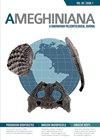Laguna Flecha Negra地区(阿根廷圣克鲁斯省)侏罗纪中晚期Bahía Laura杂岩的植物形态和古环境
IF 1.5
4区 地球科学
Q3 PALEONTOLOGY
引用次数: 0
摘要
摘要在阿根廷圣克鲁斯省的Laguna Flecha Negra地区(Bahía Laura Complex,侏罗纪中晚期)进行了地质研究。定义了沉积相和保存样式,以识别所研究序列中的植物分支相。确定了11个分支相,并提出了火山和地热系统内的植物来源。植物遗骸具有本地-准本地起源,保存最好的是硅质温泉(烧结)系统的远端相。在所研究的序列中发现了横向和垂直的taphonomic差异。这是由于沉积输入和与地热流体的距离发生了变化。这些结果使人们能够重建德塞多地块地质省这一地区的沉积历史。我们推断出温泉(烧结矿)系统的形成,该系统随后被部分改造的秋季火山碎屑亚相中安山岩溢流圆顶边缘的潜水喷发过程破坏。地热系统破坏后,河流和湖泊表碎屑亚相发育,保留了冈瓦纳大陆中晚侏罗世的典型植物群落。后来,火山活动产生了火山碎屑亚相,有来自不同来源的厚厚的火山灰降落和流动沉积物,并被时间间隔分隔开,这促进了原位森林的石化。对这些植物群落的人类学研究使我们能够重建一系列地质事件,以及这些过程如何影响巴塔哥尼亚侏罗纪植物群的保存,从而有助于了解Deseado Massif地质省的古生态。本文章由计算机程序翻译,如有差异,请以英文原文为准。
Plant Taphonomy and Paleoenvironment of the Bahía Laura Complex, Middle–Late Jurassic, at the Laguna Flecha Negra Locality (Santa Cruz Province, Argentina)
Abstract. Taphonomic studies were carried out at Laguna Flecha Negra locality (Bahía Laura Complex, Middle–Late Jurassic), Santa Cruz Province, Argentina. Sedimentary facies and preservational styles were defined to recognize plant taphofacies in the studied sequence. Eleven taphofacies were identified and plant sources within a volcanic and geothermal system are proposed. Plant remains are of autochthonous to para-autochthonous origin and best preservation was found in distal facies of siliceous hot spring (sinter) systems. Lateral and vertical taphonomic differences were found in the studied sequence. These are due to changes in the sedimentary input and distance to the geothermal fluids. Results enable the reconstruction of the depositional history of this region of the Deseado Massif geological Province. We infer formation of a hot-spring (sinter) system that was subsequently destroyed by a phreatic eruption process at the margin of an andesitic effusive dome in partially reworked fall pyroclastic subfacies. After the destruction of the geothermal system, a fluvial and lacustrine epiclastic subfacies developed preserving a plant community typical of the Middle-Late Jurassic of Gondwana. Later, volcanic activity produced pyroclastic subfacies, with thick ash-fall and flow deposits from different sources and separated by a time gap that promoted fossilization of an in situ forest. Taphonomic studies of these plant communities allowed reconstruction of a chain of geological events and how these processes have influenced the preservation of a Jurassic flora from Patagonia, thus contributing to an understanding of the paleoecology of the Deseado Massif geological province.
求助全文
通过发布文献求助,成功后即可免费获取论文全文。
去求助
来源期刊

Ameghiniana
地学-古生物学
CiteScore
2.50
自引率
10.00%
发文量
21
期刊介绍:
Ameghiniana is a bimonthly journal that publishes original contributions on all disciplines related to paleontology, with a special focus on the paleontology of Gondwana and the biotic history of the southern hemisphere. Published yearly since 1957, it has undoubtedly become the main palaeontological publication from Latin America. Ameghiniana has recently broadened its editorial board, reorganized its production process, and increased to a bimonthly frequency, which resulted in a significant decrease in the turn around time.
 求助内容:
求助内容: 应助结果提醒方式:
应助结果提醒方式:


